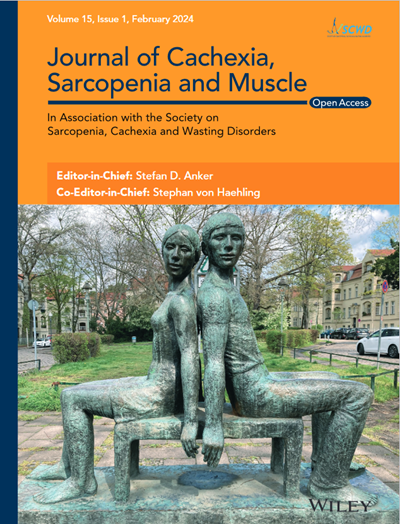Peripheral Thyroid Hormones, Inflammatory and Skeletal Muscle Indexes in Advanced Cervical Cancer Treated With Cemiplimab.
IF 9.1
1区 医学
引用次数: 0
Abstract
BACKGROUND A low fT3/fT4 ratio has been associated with poorer prognosis in several diseases. Inflammatory indexes (IIs) and the skeletal muscle index (SMI) are established prognostic factors in various cancer types. However, their interplay and individual contributions to the prognosis of cervical cancer remain unclear. This study aimed to evaluate the impact of these biomarkers on survival outcomes in cervical cancer patients treated with innovative immunotherapy. METHODS This retrospective study included 101 patients with cervical cancer treated with cemiplimab at 12 Italian oncology centres. Patients with thyroid comorbidities or missing fT3/fT4 ratio data were excluded. The primary endpoint was overall survival (OS) in relation to the fT3/fT4 ratio. Secondary endpoints included progression-free survival (PFS) and correlations between the fT3/fT4 ratio, ECOG Performance Status, IIs and SMI. RESULTS An optimal fT3/fT4 cutoff for OS prediction was identified at 0.29. Median OS was 10.9 months for patients with a low fT3/fT4 ratio, while it was not reached for those with high fT3/fT4 levels (HR = 2.70; 95% CI: 1.17-6.22; p = 0.02). Multivariate analysis confirmed that both the fT3/fT4 ratio and ECOG PS independently influenced OS. Among the IIs analysed, the systemic inflammatory index (SII) demonstrated the strongest correlation with fT3/fT4 levels (OR = 3.82; 95% CI: 1.39-10.50; p = 0.0092). Exploratory analysis also revealed significantly lower SMI values in patients with lower fT3/fT4 ratios (p = 0.034). CONCLUSIONS This study highlights the prognostic significance of the fT3/fT4 ratio, IIs, and SMI in cervical cancer patients treated with cemiplimab. Given the exploratory nature of these findings, further validation in larger, prospective cohorts is warranted to support their integration into clinical practice and the development of innovative prognostic tools.西米单抗治疗晚期宫颈癌的外周血甲状腺激素、炎症和骨骼肌指标。
背景:在一些疾病中,低fT3/fT4比率与较差的预后相关。炎症指数(IIs)和骨骼肌指数(SMI)是各种癌症类型的预后因素。然而,它们之间的相互作用和个体对宫颈癌预后的影响尚不清楚。本研究旨在评估这些生物标志物对接受创新免疫治疗的宫颈癌患者生存结果的影响。方法本回顾性研究纳入意大利12个肿瘤中心101例宫颈癌患者接受塞米单抗治疗。排除有甲状腺合并症或fT3/fT4比值缺失的患者。主要终点是与fT3/fT4比率相关的总生存期(OS)。次要终点包括无进展生存期(PFS)和fT3/fT4比率、ECOG性能状态、IIs和SMI之间的相关性。结果fT3/fT4预测OS的最佳临界值为0.29。fT3/fT4比值低的患者中位OS为10.9个月,而fT3/fT4比值高的患者中位OS未达到(HR = 2.70; 95% CI: 1.17-6.22; p = 0.02)。多因素分析证实fT3/fT4比值和ECOG PS独立影响OS。在所分析的i中,全身炎症指数(SII)与fT3/fT4水平相关性最强(OR = 3.82; 95% CI: 1.39-10.50; p = 0.0092)。探索性分析还显示,fT3/fT4比值较低的患者SMI值显著降低(p = 0.034)。结论本研究强调了fT3/fT4比值、IIs和SMI在宫颈癌患者接受塞米单抗治疗中的预后意义。鉴于这些发现的探索性,需要在更大的前瞻性队列中进行进一步验证,以支持其融入临床实践和开发创新的预后工具。
本文章由计算机程序翻译,如有差异,请以英文原文为准。
求助全文
约1分钟内获得全文
求助全文
来源期刊

Journal of Cachexia, Sarcopenia and Muscle
Medicine-Orthopedics and Sports Medicine
自引率
12.40%
发文量
0
期刊介绍:
The Journal of Cachexia, Sarcopenia, and Muscle is a prestigious, peer-reviewed international publication committed to disseminating research and clinical insights pertaining to cachexia, sarcopenia, body composition, and the physiological and pathophysiological alterations occurring throughout the lifespan and in various illnesses across the spectrum of life sciences. This journal serves as a valuable resource for physicians, biochemists, biologists, dieticians, pharmacologists, and students alike.
 求助内容:
求助内容: 应助结果提醒方式:
应助结果提醒方式:


